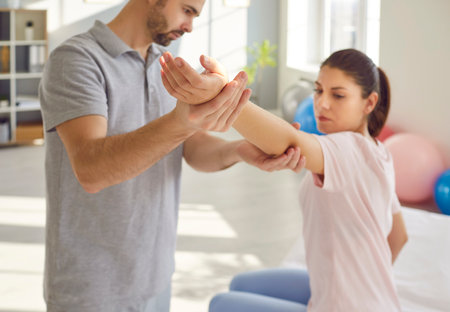1. Understanding Nerve Pain: Causes and Challenges in India
Nerve pain, also known as neuropathic pain, is a condition that affects countless people across India, often quietly impacting daily routines and family life. In simple terms, neuropathic pain arises when the nerves in our body are damaged or not working properly, leading to sensations like burning, tingling, numbness, or shooting pains. For many Indians, this type of pain can be linked to common health conditions such as diabetes, injuries from road accidents, infections like herpes zoster (shingles), or even lifestyle-related issues such as prolonged sitting at work. Cultural practices and beliefs also shape how people perceive and manage nerve pain; some may see it as a natural part of aging or rely on home remedies passed down through generations before seeking medical help. Living with nerve pain can be challenging—not just physically, but emotionally too—affecting one’s ability to participate in social gatherings, religious rituals, or simply enjoy a cup of chai with loved ones. Understanding what causes neuropathic pain and recognising its impact within the Indian context is the first step towards finding relief and regaining comfort in everyday life.
2. What is Panchakarma? An Ancient Healing Science
Panchakarma is a cornerstone of Ayurveda, the traditional Indian system of medicine that has been practiced for thousands of years. Rooted in ancient Sanskrit texts and enriched by centuries of wisdom, Panchakarma literally means “five actions.” These five therapeutic procedures aim to detoxify, cleanse, and rejuvenate the body at a deep cellular level. In India, Panchakarma is not just a treatment but a cultural heritage—often passed down in families and trusted by generations for restoring balance and health.
Panchakarma plays a significant role in modern Indian wellness traditions, especially when addressing chronic conditions like nerve pain (neuropathic pain). The therapy is designed to remove toxins (ama), restore digestive fire (agni), and balance the three doshas: Vata, Pitta, and Kapha. This holistic approach helps in calming inflamed nerves, easing pain, and improving overall vitality. Below is a summary of the core processes involved:
| Panchakarma Process | Purpose | Indian Context & Common Terms |
|---|---|---|
| Vamana | Therapeutic Emesis (removal of toxins via vomiting) | Often recommended for Kapha-related imbalances, known as “Shodhana” |
| Virechana | Purgation therapy (cleansing bowels) | Popular in South India; helps with Pitta disorders |
| Basti | Medicated enema (colon cleansing) | Mainstay for Vata disorders; commonly practiced in Kerala |
| Nasya | Nasal administration of herbal oils/juices | Used for sinus and nervous system issues; familiar in North Indian households |
| Raktamokshana | Bloodletting (removal of impure blood) | Lesser used today but still found in rural Ayurvedic clinics (“Siravedha”) |
Panchakarma’s acceptance in Indian society goes beyond clinical settings—it is often part of seasonal routines (like “Ayurvedic detox” before monsoon or after festivals) and family wellness practices. Many urban wellness centers and rural clinics alike offer personalized Panchakarma programs tailored for lifestyle diseases, including neuropathic pain. Its integration with physiotherapy represents a unique blend of tradition and modern science that resonates with many Indians seeking gentle yet effective relief from nerve pain.
![]()
3. Physiotherapy: Modern Rehabilitation Tactics
Physiotherapy has become a vital part of nerve pain (neuropathic) management across India, complementing traditional Ayurvedic therapies like Panchakarma. In cities from Delhi to Bengaluru and even in smaller towns, skilled physiotherapists play an essential role in helping patients regain movement, reduce pain, and improve quality of life. These healthcare professionals are trained to assess the specific needs of each patient—sometimes working closely with neurologists or Ayurvedic practitioners for a holistic approach.
The Role of Physiotherapists in India
Indian physiotherapists are much more than exercise instructors; they are rehabilitation experts who design personalised treatment plans. Their work often begins with a thorough assessment using both clinical examination and patient history, followed by setting achievable goals that resonate with the individuals lifestyle and daily needs. Building trust is important in Indian culture, so therapists often take time to explain procedures and offer emotional support, making the journey less daunting for patients and their families.
Popular Treatment Modalities for Nerve Pain Relief
Physiotherapy clinics across India offer a wide range of evidence-based modalities tailored for neuropathic pain relief. Some commonly used methods include:
TENS (Transcutaneous Electrical Nerve Stimulation)
This therapy uses mild electrical currents to disrupt pain signals, providing significant relief for many Indian patients, especially those suffering from diabetic neuropathy—a common concern in the country.
Manual Therapy & Therapeutic Exercises
Hands-on techniques such as soft tissue mobilisation, stretching, and guided exercises help restore nerve function and reduce stiffness. Customised exercise regimens are particularly popular, as they can be practised at home, fitting into busy Indian routines.
Ultrasound Therapy
This modality is widely used to promote tissue healing and reduce inflammation around affected nerves.
Lifestyle Guidance
Physiotherapists also advise on posture correction, ergonomics (especially relevant for India’s growing IT workforce), and simple home remedies like hot fomentation. They may recommend adaptations in daily activities to ensure long-term nerve health.
With a blend of scientific knowledge and cultural sensitivity, Indian physiotherapists empower patients to reclaim independence—making physiotherapy an indispensable pillar in the Panchakarma & Physiotherapy combo for nerve pain relief.
4. Synergistic Benefits: Why a Combined Approach Works
In India, where traditional healing wisdom and modern medical science often go hand in hand, the combination of Panchakarma and physiotherapy offers unique benefits for those suffering from nerve pain (neuropathic pain). Each therapy brings its own strengths to the table, but together, they create a powerful synergy that addresses not just symptoms, but also root causes.
Panchakarma: Ancient Wisdom for Deep Healing
Panchakarma is a cornerstone of Ayurveda, focusing on detoxification, balancing doshas, and rejuvenation. Its therapies—like Abhyanga (oil massage), Swedana (herbal steam), and Basti (medicated enema)—work at a cellular level to reduce inflammation and restore the body’s natural harmony. In the Indian context, Panchakarma is highly personalized, often tailored to one’s Prakriti (body constitution) and specific health conditions.
Physiotherapy: Modern Science for Functional Recovery
Physiotherapy provides evidence-based interventions such as targeted exercises, manual therapy, and electrotherapy. These techniques improve nerve function, reduce muscle stiffness, and enhance mobility—key elements for neuropathic pain management. In India, physiotherapists often incorporate locally relevant practices like yoga-based stretches or therapeutic movements inspired by daily activities.
How the Combo Enhances Nerve Pain Relief
| Aspect | Panchakarma | Physiotherapy | Combined Effect |
|---|---|---|---|
| Root Cause Addressed? | Yes – detoxifies & balances doshas | No – focuses on symptom relief & function | Treats root cause & symptoms together |
| Body-Mind Connection | Strong emphasis (Ayurvedic approach) | Moderate (through relaxation techniques) | Holistic wellness: physical & mental balance |
| Cultural Relevance in India | Deeply rooted in tradition; familiar rituals | Evolving with local adaptations like yoga therapy | Greater acceptance & adherence among Indian patients |
| Sustainability of Relief | Long-term through lifestyle changes & immunity boosting herbs | Short to medium-term via functional improvement | Improved outcomes & longer-lasting relief |
A Unique Indian Advantage
The blend of Panchakarma and physiotherapy is especially effective in India due to cultural familiarity with Ayurvedic practices and increasing access to physiotherapy in both urban and rural areas. Patients feel more comfortable integrating these approaches into their lives, leading to better compliance and holistic recovery. This culturally attuned synergy not only relieves nerve pain but also empowers individuals to maintain their well-being in the long run.
5. Personalising Treatment: Lifestyle, Diet, and Indian Home Remedies
When it comes to relieving nerve pain through the Panchakarma and Physiotherapy combo, personalisation is key. Each individual’s journey with neuropathic pain is unique, and integrating lifestyle modifications, dietary tips, and Indian home remedies can make a meaningful difference. Here’s how you can complement your clinical interventions with everyday practices rooted in Indian tradition.
Understanding Your Bodys Needs
Ayurveda teaches us that each person has a distinct constitution (Prakriti). Consulting with your Ayurvedic doctor or physiotherapist helps identify your body type and specific needs. This way, treatment—including daily routines—can be tailored for maximum relief from nerve discomfort.
Traditional Indian Dietary Tips
- Include Anti-inflammatory Foods: Turmeric (haldi) milk, ginger tea, and foods rich in omega-3s like flaxseeds and walnuts help reduce inflammation that often aggravates nerve pain.
- Warm, Light Meals: Opt for easily digestible khichdi, dal, or steamed vegetables to avoid overloading the digestive system. Spices like cumin (jeera), coriander (dhaniya), and fenugreek (methi) are traditionally used to enhance digestion and support overall healing.
- Avoid Excessive Stimulants: Minimise intake of deep-fried snacks and caffeinated drinks. Instead, hydrate with herbal infusions such as tulsi (holy basil) tea or fennel water.
Lifestyle Modifications Rooted in Indian Wisdom
- Daily Abhyanga (Oil Massage): Applying warm sesame or coconut oil to affected areas before bathing not only nourishes the nerves but also supports blood circulation—a practice widely recommended in Panchakarma therapies.
- Mild Yoga & Pranayama: Gentle yoga stretches such as Tadasana (Mountain Pose) or Sukhasana (Easy Pose) combined with deep breathing exercises help relax tense muscles and calm nerve irritation. Always consult your therapist before beginning new exercises.
- Quality Sleep: Ayurveda emphasises early bedtime. Creating a calming bedtime routine—such as listening to soft bhajans or practising guided meditation—can improve sleep quality and support recovery from nerve pain.
Indian Home Remedies for Everyday Support
- Turmeric Paste: A simple paste made from turmeric powder and water can be gently applied to sore areas for its soothing effect.
- Epsom Salt Soaks: Adding Epsom salt to warm water for hand or foot soaks helps ease muscle tension around nerves—a remedy popular in many Indian homes.
A Gentle Reminder
While these lifestyle and home remedies offer gentle support, they work best when integrated with professional Panchakarma therapies and physiotherapy sessions. Always seek personalised advice from your healthcare provider before starting any new regimen. With mindful attention to daily habits, traditional foods, and age-old remedies, you can create a nurturing environment for your nerves—right at home in India.
6. Choosing Your Care: Indian Clinics, Practitioners, and Next Steps
Finding the right place for Panchakarma and physiotherapy in India can feel overwhelming at first, but with some thoughtful steps, you can select a trustworthy centre to support your nerve pain relief journey. Start by looking for clinics that are either NABH (National Accreditation Board for Hospitals & Healthcare Providers) accredited or have good reviews from Indian clients. Reputable Ayurvedic hospitals and physiotherapy centres across cities like Kerala, Bengaluru, Mumbai, or Delhi often display their certifications proudly and follow transparent treatment protocols.
What to Expect During Your First Visit
At your initial appointment, experienced practitioners will generally begin with a detailed health assessment. In an Ayurvedic clinic, expect questions about your diet, lifestyle, sleep patterns, and medical history—Ayurveda focuses on understanding your prakriti (constitution) and current imbalances. For physiotherapy, expect a physical examination to check your posture, movement limitations, and pain points. Both systems value personalised care plans tailored to Indian lifestyles and dietary habits.
Questions to Ask Your Practitioner
- Is the practitioner certified by the Central Council of Indian Medicine (CCIM) or Rehabilitation Council of India (RCI)?
- How many years of experience do they have treating neuropathic pain?
- Can they share patient testimonials or case studies specific to nerve pain?
- How will Panchakarma therapies be customised for my condition?
- Will I receive guidance on Indian home remedies or diet plans post-therapy?
Taking Your Next Steps
If you are comfortable after the consultation, ask about package options—many Indian centres offer combo therapy packages at a reduced rate. Check if they provide follow-up support via WhatsApp or phone calls, a common practice in India for ongoing care. Finally, trust your instincts; choose a clinic where you feel heard and supported. With proper guidance and the rich tradition of Indian healing systems, you are taking a positive step towards managing neuropathic pain in a holistic way.

